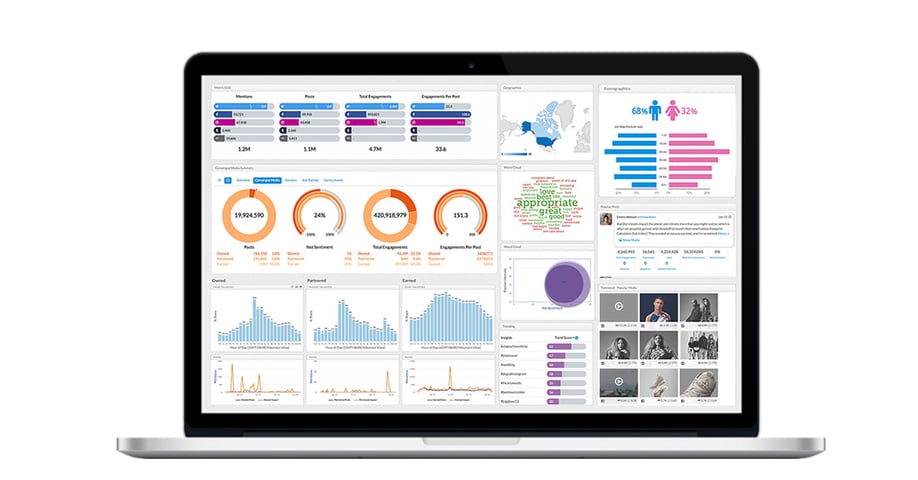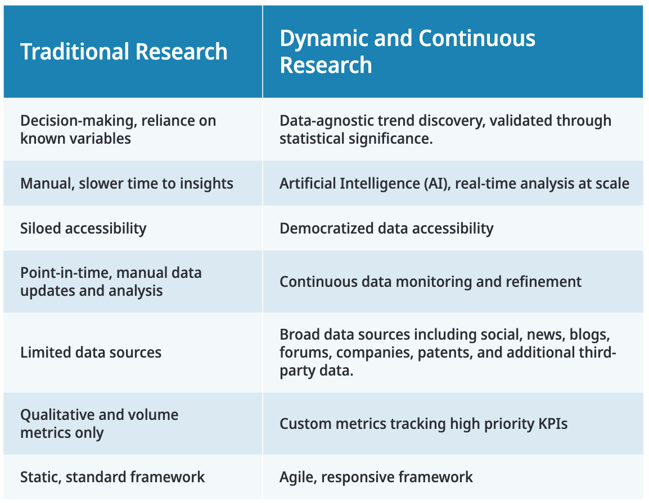Admin

Blog Summary
This blog delves into the evolution of market research, comparing traditional methods with modern strategies, and the integration of both to improve decision-making in business.
Key Points Overview
Top Takeaways
Conclusion
Embracing both traditional and modern market research methodologies can significantly enhance a company's strategic decisions. This integration not only optimizes costs but also enriches the quality of insights, driving competitive advantages in an ever-evolving market landscape.
Decision-making in business is fraught with uncertainties. Through market research, companies reduce these uncertainties, build confidence, and achieve mission critical business objectives. Let’s see how it looks!
Market research is a dynamic field. Whether management chooses a newer or older approach can have a considerable effect on the quality of decisions it makes based on the findings. We’ll share some insight about traditional market research vs modern strategies below!
The advent of the digital age has undoubtedly been a boon for market researchers across the globe. On one hand, there are tested traditional methods that the field has relied on for generations. These remain a viable option for the modern researcher who views them as an irreplaceable approach to studying the markets.
But there’s no reason those sources can’t be enhanced to keep pace with the explosion of new technology that affords the researcher tools and methods to perform these tasks on a whole new level. The advantages of cost-effectiveness, speed, and convenience technology offers are hard to ignore.
So, let’s compare them to see how they differ and maybe it will charge your creativity to find ways to marry the two at your organization.
Both modern and traditional market research follow a systematic process that always has the same goal: To search for and interpret information leading to the solution of an identified problem. And there are four major phases of the research process.
All effective market research leads with a problem (referred to as the research problem). The way the problem is defined in modern and traditional market research methodologies leads them down different paths.
In the past, the purpose of research was to find suitable customers for a product. This meant the research problem was defined in terms that sought maximum profit for the business. This route results in push marketing strategies. In modern market research, the process is customer-facing. Rather than find suitable customers for the product, the purpose of research is to create a suitable solution to meet the needs of the consumer. The research problem is stated as a search for ways to improve customer satisfaction. This results in pull marketing strategies.
Any hybrid research even goes a step further, loosely holding an idea of what they are searching for and leaving the exact direction open depending on the insight that is surfaced from qualitative and qualitative methods. This discovery puts a finer point on the process, with the resulting “solution” offering companies new possibilities to explore.

Research design refers to the framework adopted for the completion of a study including the tools, techniques, and type of study (exploratory, descriptive, or causal research). This is determined by the research problem. Depending on the design chosen, there are implications on the relationship between the researcher and the subject as well as the cost of the research. However, this plays out differently in the modern vs. traditional approaches.
Traditional market research is designed to provide an in-person participation by the researcher and the subject. The tools and techniques used facilitate a face-to-face interaction between the two parties. This assumption here is that it results in a more nuanced process where the researcher gathers more data on the subject beyond their verbal responses. But this also means it costs more to do things traditionally – and the results are flavored by researcher bias.
On the other hand, modern market research uses advanced communication tools and techniques that do not require respondents and researchers to be in the same location. And it also eliminates any chance of bias. So the Q&A here is actually more accurate than what is found using traditional methods. Respondents don’t even have to participate at the same time. Sometimes, subjects don’t have to participate at all, only their data being required. This allows a lot more flexibility and convenience to both parties and leads to lower long-term costs.
Hybrid methods are big on capturing nuance with advanced AI-powered capabilities that not only expand an audience to global levels, but catches trouble spots and opportunities well before a human eye will.
Data is the fodder for research studies. The type of data required, the ability to collect it, and the methods used all play an important role in the overall success of the study. The researcher’s options vary greatly if they are using modern vs. traditional market research strategies.
Being in-person, traditional market research allows for more direct methods of data collection. These include focus groups, surveys, interviews, ethnography, and intercepts. The data collected this way is often thought to be of a higher quality although the number of subjects is smaller compared to the alternative.
Modern market research strategies are mainly indirect, applying digital technology tools that can allow passive and indirect participation by subjects, which is what today’s consumer typically prefers. The methods used include everything gathered before but in digital form: online surveys, email questionnaires, netnography, and social listening. The data collection is more convenient for both parties encouraging participation whether it is having permission to access data or actively responding. And it offers advanced insight, as respondents answers aren’t biased or led by the researcher interaction.
The end product of market research is a conclusion and recommendation. Before that is data analysis which refers to the breaking down of a dataset into its constituent parts to reveal its nature.
Based on the research problem, analysis of traditional market research is skewed towards identifying ways to increase the chances of the product in the market. This is the “must know” information that answers to the priorities of the research commissioner. In customer-oriented market research, the approach of modern strategies, the interpretation of data is geared towards creating information that can be used to improve customer satisfaction. But a hybrid approach does both, really – and at scale.
Not only that, but this dynamic market research minimizes, if not entirely does away with, analyst bias. There are no presumptions about the research that will flavor the conclusions and this creates research results with exceptional validity and credibility – intel that brands can bet that next move on.
The differences between the two methods (traditional/segmented research vs dynamic/hybrid research) are immediately apparent below:

Evidently, both modern and traditional market research strategies have their unique strengths and weaknesses. When used together, they can result in a hybrid methodology that is more effective than either one of them.
Savvy brands will want to use this vs. choosing between the two methods. For instance, the cost-prohibitiveness of traditional market research can be answered with the efficiency of modern strategies through live online surveys on video conferencing platforms. This allows the researcher to collect both audio and visual insights.
The quality of information can be improved in modern strategies through social listening which collects large volumes of data (big data) which is authentic and freely generated outside the context of research. A cogent example of this is how in November 2016 social media analytics more accurately forecasted the outcome of the US presidential election than national polls which had been the go-to resource for decades.
By using new generation AI technology to collect and analyze data, Quid® allows you to conduct hybrid market studies. We facilitate the aggregation of all sorts of unstructured data across the internet and integrating online and offline data sources for unified analyses. This means that you don’t have to sacrifice the strengths of one approach and suffer avoidable weaknesses because you chose the other. Reach out for a demo today to see how this works – and why it sets today’s leading brands apart from the rest!